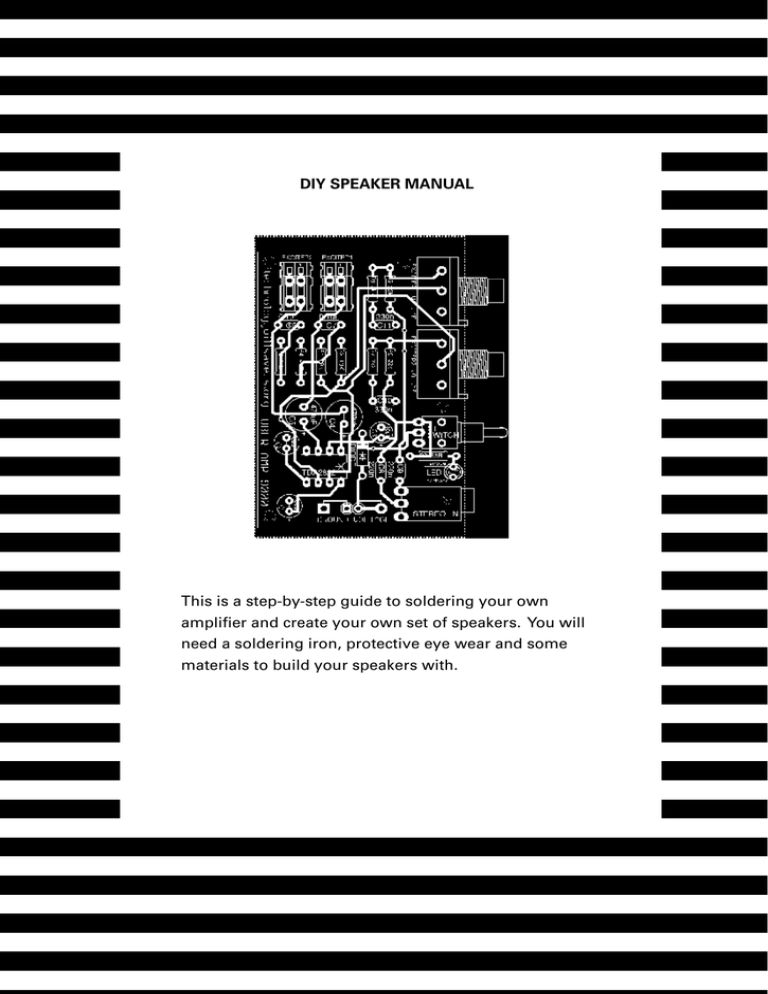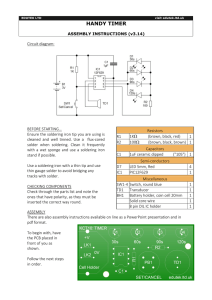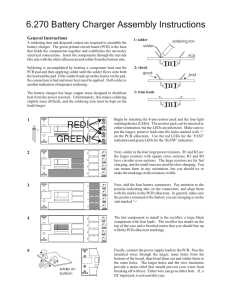DIY SPEAKER MANUAL DIY SPEAKERS MANUAL
advertisement

DIY DIY SPEAKER SPEAKERSMANUAL MANUAL This is a step-by-step guide to soldering your own amplifier and create your own set of speakers. You will need a soldering iron, protective eye wear and some materials to build your speakers with. We hope you enjoy this creative task, learn some new technological skills and apply them to your life in useful ways. Enjoy! MAKING YOUR DIY SPEAKERS PARTS: 1) 1 X 10 K Ohm Resistors ( Brown, Black, Orange, Gold ) 2) 2 X 4.7 Ohm Resistors ( Yellow, Violet, & Gold ) 3) 1 X 33 Ohm Resistor ( Orange, Orange, Black, Gold ) 4) Diode (black tube with grey mark on one end) 5) 1 X Red LED (Light Emitting Diode) 6) 1 X Stereo Input Jack 7) 1 X Switch 8) 1 X 8 Pin black socket 9) 2 X 100 nF (nano Farad) Capacitors 10) 1 X 10 nF Capacitors 11) 3 X 10 uF Capacitors (cylinder) 12) 1 X Black Terminal Block 13) 1 X 4.7 K Ohm Potentiometers (variable resistors) 14) 1 X 8 Pin Integrated Circuit (IC) TDA2822 amplifier 15) 1 X Battery Holder 16) PCB - printed circuit board with stereo jack attached 17) Stereo cable 18) Double Sided Foam Tape 19) 1 X Exciters (Speakers) 20) Exciter cable Additional Equipment 21) Blue or White Tack (not included, but helpful for soldering) 22) Solder 23) Solder Sucker 24) Wire Cutters 15 1 12 16 2 3 4 5 9 7 6 8 18 11 10 14 13 24 21 19 20 23 17 22 1. Diode 1.1 Get your blue tack and push into the table to give a good base for your circuit board. This will be your friend for the next could of hours and will work as your helping hands to secure your PCB while soldering. 1.2 The diode has a direction - which means it must go into the PCB the right way! Match the grey mark on the diode with the grey mark on the PCB. 1.3 Bend the diode’s legs 90 degrees. Make the bend at around 3mm away from either side of the black cylinder.. 1.4 Insert it into the PCB. Top tip: Remember direction match the grey mark on the diode to the mark on the PCB. 1.5 Turn the PCB around and bend the legs of the diode at around 45 degrees to the board. 1.6 Solder the Diode to the PCB! - Take out your soldering iron, and touch the side of the tip to the point at the PCB where the leg meets the solder pad. - Heat the point where they meet for 3-4 seconds. - Add solder until enough melts to cover the solder pad and the base of the diode’s leg. - Remove the solder and leave the iron for another second. - Remove the soldering iron and you should be left with a perfectly soldered joint! Top tip: Melted solder likes to attach itself to very hot surfaces - so you want to make sure that both the parts you’re trying to connect are given equal heat. Otherwise you’ll end up with what is called the dreaded “cold joint”, which will result in an F in your soldering exam! Top Tip: Follow the solder iron up along the solder to create a nice finish. 1.7 After soldering both the legs, pick up the side cutters in one hand. Hold one of the legs of the diode, with your other hand. Clip it at its base. Repeat for the other leg. Top tip: You’re holding the leg to prevent it from flying into your or someone else’s eyeball! Please remember that eyeballs are not easily replaceable and you should always be very careful when clipping the legs off of your components. 2. Resistors: 2.1 Take any one of your resistors and bend both the legs as close to the resistor’s body as you can. Use your finger or the table to help! 2.2 Repeat this with all the resistors. 2.3 Place the resistors in the following order. Positions: - R1: 10 K (Brown, Black, Orange, Gold) - R2: 33 Ohm ( Orange, Orange, Black, Gold ) - R3 & R4: 4.7 Ohm (Yellow, Violet, Gold, Gold) 2.4 Bend all their legs out 45 degrees, and solder them in place. Once soldered, clip of the legs with your side cutters. (Remember to hold onto the leg!) 3 Capacitors: 3.0 We’ll begin by soldering the non-polarized capacitors. IE: the ones which can go into their places any way around! Find the 10nF, and 100nF blue capacitors. TOP TIP: These guys look the same so look out for the number 10 written on the cap to distinguish which is which. 3.1 Insert the capacitors in the following positions: - 10nF capacitors into C4 - 100nF capacitors into C5 & C6 Once soldered in place & bend, clip the legs. 3.2 Electrolytic Capacitors. WARNING! These ones are polarized - which means they can only go into the PCB in a particular way. Take the 10uF capacitor and look at its legs. You’ll see that one is longer than the other. Top tip: If you ever find an electronic component with different length legs, you know immediately that it can’t be installed any which way. So pay attention to its orientation 3.3 If you look at the PCB, you’ll see a “+” next to one of the plated holes. The long leg is “plus sized”, so it should be inserted next to the “+”. 3.4 With this in mind, Insert the electrolytic capacitors into the following positions: - 10uF capacitors into C1, C2 and C3 3.5 Turn over the PCB and bend the legs of all the electrolytic capacitors out at 45 degrees. Solder them all in, and clip the legs. 4. LED LED (Light Emitting Diode) Take the LED and look at its legs. You’ll see that one is longer than the other. This means that it has to be inserted into the PCB in the right way! The longer leg is called the Anode - which likes to have power and the shorter one is the Cathode - which likes to have ground. 4.0 Insert the LED and solder it in place. 5. 8Pin Black Socket 5.0 Take the 8 pin black socket and insert it where the PCB is marked “TDA2822“. You’ll notice there is a notch in the illustration on the PCB and a notch in the 8 pin socket. Keep these aligned when inserting, and solder it in! 6. Stereo Jack 6.0 Take the black stereo jack and place it next. It will slot very comfortably in place where the PCB says “Stereo IN”. Solder it in and move onto the next component! 7. Switch 7.0 Insert the Switch into the position marked “S1” adjacent to the LED. Solder all 5 pins in place. 8. Potentiometer 8.0 Solder the potentiometer in place. 9. Integrated Circuit (IC): Top Tip: The reason for using a socket is to make sure that we don’t over-heat the IC by soldering it directly. 9.0 The IC is an amplifier chip. It must be placed inside the 8 pin socket you soldered previously. If you look carefully at the chip, you’ll see a notch in the centre of the one end. 9.1 Carefully insert the IC into its socket so that the notch is directed towards the LED. 9.2 It will fit nice and snug into the socket. 10. Terminal Blocks 10.0 Solder in the black Terminal Block connectors. 10.1 Your amp is now almost complete!! 12. Attach your Exciter 12.0 The exciter (speaker) has two cables that firstly need attaching. 12.1 Firstly twist the ends of the wires to give you a nice neat finish, then trim to your desired length around 10mm is fine. 12.2 Next feed the wire through the small hole on the exciter. 12.3 Then solder the wire in place to create a good connection with the metal pad beneath. 12.4 Your amplifier has a black terminal block connector with 2 ports. All you need to do is match one port with one of the exciters wires! Depress one of the white levers of the terminal blocks and then insert one of the wires from the exciter into the slot. 12.5 Once both wires are inserted the amp is ready to be tested. 13. The battery holder: 13.0 Before we solder the battery holder in place, its a good idea to test test test! So insert 2x AA batteries (not included) into the battery holder. 13.1 Insert the battery holder into the PCB from behind. It goes in on the edge of the board closest to the IC. Bend its legs out at 45 degrees to keep it in place. It will also ensure that they make contact with the conductive pads which we will solder them to later. Turn the switch on... Does the LED go on? If so, congratulations! If not, try the following: 1) press down on the bent legs of the battery to ensure contact. 2) Try the switch again in both directions while pressing the battery legs. 3) Are you sure you put batteries in? 4) Go back through the manual and make sure you put everything in the right way around. 5) Check the forum at twsu.co/forum for support 13.2 Remove the battery holder and find the double sided foam tape. Attach the foam tape to the back of the battery holder on the other end to the legs. Then reveal the other sticky side of the tape before inserting the legs back into the PCB. 13.3 Solder the legs in place and trim them. 14. Stereo Cable 14.0 Now its time to check its all working. Plug in your stereo cable and attach to a music playing device. You should feel the exciter vibrating. Use the potentiometer to adjust the volume and see the vibrations increase and decrease. CONGRATULATIONS! You have now completed your amp, and attached it to your exciters! All that is left is to attach the exciters to various materials, and begin experimenting with sound waves and surfaces. Enjoy exploring different material’s responses to the vibrations emitted by your exciters. Then decide on a material you want to become your speakers and use then use the sticky pad on your exciter to permanently fix it to your chosen material! THANK YOU Technology Will Save Us exists to educate and inspire people to make, tinker and experiment creatively with technology as a way of unleashing new possibilities. Devices, gadgets, computers are all a part of our everyday life and yet most people know so little about what these things are made of, let alone how to fix them or create new uses for them. We believe that the opportunity for technology to play a richer, more creative role in our lives has yet to be explored. Interested in more classes? Have an idea of a workshop we should teach? Do you want to teach a class? We’d love to hear from you. Contact us on email or find out more on our website: info@technologywillsaveus.org www.technologywillsaveus.org @techwillsaveus

